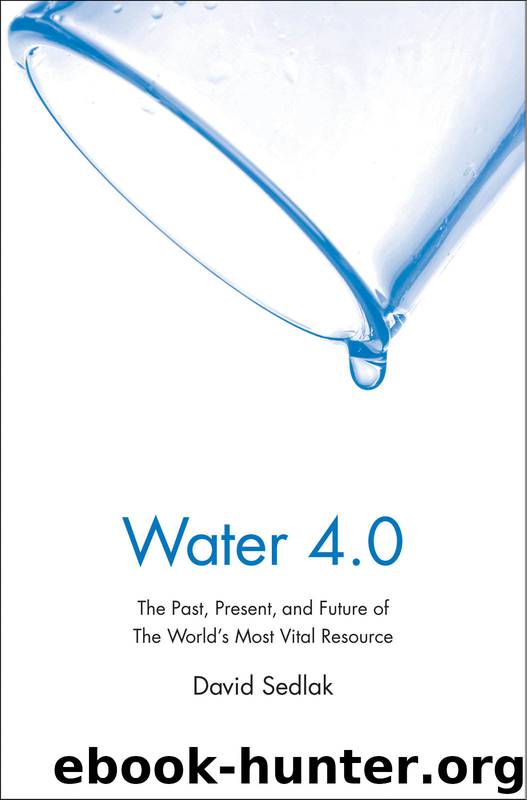Water 4.0: The Past, Present, and Future of the World's Most Vital Resource by David Sedlak

Author:David Sedlak
Language: eng
Format: mobi, azw3
Publisher: Yale University Press
Published: 2014-01-27T14:00:00+00:00
California’s major aqueducts provide most of the water used by the state’s cities and farms.
Water systems that rely on gravity or local rivers and lakes often use less energy than the national average to provide water. So which cities have energy usages that pull up the national average? Los Angeles is not alone in its reliance on pumps to push water over mountains. For example, water from the Colorado River in Arizona is pumped to an elevation that is even higher than that of the Tehachapi Mountains as it climbs up to the red rocks surrounding Tucson.30 The $5 billion Central Arizona Project is typical of the way that water projects were designed in the days when electricity was cheap and federal investments allowed arid regions to build massive systems to deliver water to cities and farms with little consideration of their long-term viability. With the low electricity prices of the twentieth century, these energy-intensive systems could be justified, but it will be hard to expand them or to build similar systems if electricity prices double or triple in the future.
The national average for energy consumption in water systems is also pulled up by cities that rely on groundwater. Overall, groundwater systems use about 30 percent more electricity than the national average for all types of water systems.31 Although its acquisition frequently requires more electricity for pumping, groundwater is often attractive as a water source because it can usually be used as a drinking water supply with little or no treatment. It is also cost-effective if it can be obtained locally, because the investment in canals or pipelines to move it to the city can be avoided. Due to the costs associated with drilling wells and pumping water up to the surface, however, the first set of groundwater wells are usually dug to the shallowest depth at which clean water can be obtained. Therefore future exploitation of groundwater is likely to be even more energy intensive because the new wells will have to be dug to depths deeper than those that are already in use.
The second reason we consume so much electricity in modern water systems is that we need to pressurize water to get it to flow through an extensive underground pipe network and we often set the pressure for large sections of the system at values that assure that the minimum desired pressure will be experienced in the farthest faucet. To ensure that there is enough water pressure to reach the second or third floor showerhead or to fight a two-alarm fire requires relatively high water pressure. This arrangement is in contrast to the ancient Roman systems, where most of the water flowed out at street level from a relatively small number of fountains. Overall, the energy required to pump water through a modern water distribution system accounts for about a quarter of the energy consumed after the water reaches the drinking water treatment plant.32 And when we fail to adequately maintain pipe networks, the cost of pumping
Download
Water 4.0: The Past, Present, and Future of the World's Most Vital Resource by David Sedlak.azw3
This site does not store any files on its server. We only index and link to content provided by other sites. Please contact the content providers to delete copyright contents if any and email us, we'll remove relevant links or contents immediately.
Kathy Andrews Collection by Kathy Andrews(11765)
The remains of the day by Kazuo Ishiguro(8891)
Spare by Prince Harry The Duke of Sussex(5140)
Paper Towns by Green John(5136)
The Body: A Guide for Occupants by Bill Bryson(5027)
Industrial Automation from Scratch: A hands-on guide to using sensors, actuators, PLCs, HMIs, and SCADA to automate industrial processes by Olushola Akande(5024)
Machine Learning at Scale with H2O by Gregory Keys | David Whiting(4258)
Be in a Treehouse by Pete Nelson(3996)
Never by Ken Follett(3882)
Harry Potter and the Goblet Of Fire by J.K. Rowling(3808)
Goodbye Paradise(3761)
Into Thin Air by Jon Krakauer(3348)
The Remains of the Day by Kazuo Ishiguro(3346)
Fairy Tale by Stephen King(3307)
The Cellar by Natasha Preston(3297)
The Genius of Japanese Carpentry by Azby Brown(3254)
120 Days of Sodom by Marquis de Sade(3226)
The Man Who Died Twice by Richard Osman(3040)
Drawing Shortcuts: Developing Quick Drawing Skills Using Today's Technology by Leggitt Jim(3037)
